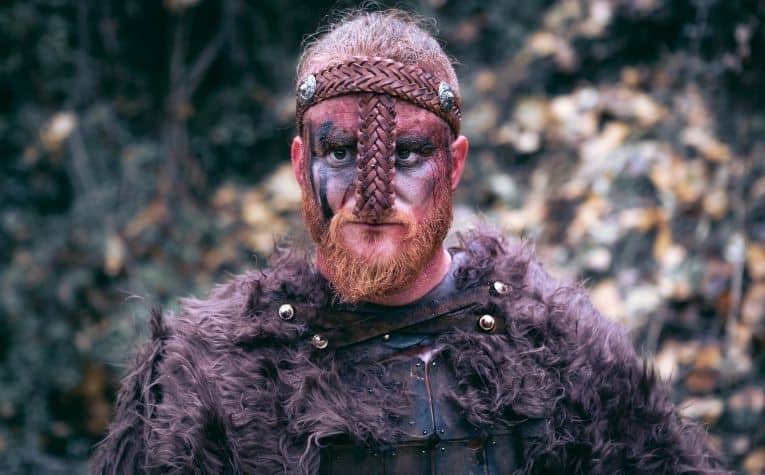In many depictions of Vikings in popular culture, they are shown as tough, rugged, and militant, with tattoos and painted faces.
But is this true? Did the Vikings really paint their faces?
There is evidence suggesting that the Vikings painted their faces. Why they painted their faces is not well understood because the Vikings didn’t leave written historical records.
While some historians believe their face painting was for appearances only, others suspect it may have been to convey a message to anyone who laid eyes on them.
The information below explains what is known and not known about the Vikings painting their faces in Scandinavia during the Middle Ages.
Also, see What Did the Vikings Look Like? to learn more.

Evidence of Vikings Using Face Paint
While no direct visual records from the Viking era exist, various pieces of evidence suggest there is some evidence that they might have painted their faces.
A description from English writings
Many historical discussions about the appearance of Vikings refer to the writings of Ibrahim ibn Yaqub (also known as Al-Tartushi), who visited the Viking town of Hedeby around the year 965 A.D.
Yaqub mentioned in his writings that Viking men and women used some indelible cosmetics to “enhance the beauty of their eyes.” [1]
Some interpretations of the texts teach that Ibrahim referred to the Danish Vikings at Hedeby, a town on the southern tip of the Jutland Peninsula in Northern Europe.
The Vikings in that region were known to line their eyes with Kohl, a black powder, usually, antimony sulfide or lead sulfide, used as eye makeup. [2]
Yaqub’s description suggests that at least some Vikings put a foreign substance on their face to change or enhance their appearance.
Modern portrayals of Viking face paint
Modern portrayals often show Vikings with painted faces, but determining the historical accuracy of these depictions is challenging.
The primary reason for this uncertainty is that there are no photographs or direct visual records from the Viking era to confirm or refute such representations.
Instead, our understanding relies on artifacts, written accounts, and archaeological findings, which may not provide a complete picture of Viking face-painting practices.
Also, see What Did the Vikings Wear? to learn more.
The Symbolism of Painted Faces
In the Viking culture, symbols held profound significance.
While the exact meanings behind each design or color remain a subject of debate, several theories have emerged based on historical texts and artifacts.
On the battlefield
Face paint, when used in battle, could have served as a form of intimidation.
Bold designs and colors might have been intended to strike fear into the hearts of enemies, making the Vikings appear more formidable.
Additionally, certain patterns could have signified rank or clan affiliations, helping to identify warriors on the battlefield.
Religious uses
Beyond warfare, face paint likely held spiritual or religious meanings.
The Vikings were deeply spiritual people, and they might have painted their faces during religious ceremonies or festivals.
Certain colors or symbols could have been used to invoke protection from the gods or to ward off evil spirits.
Reasons related to special occasions
Furthermore, face paint could have been a form of artistic expression.
Just as we use makeup today to enhance or alter our appearance, Vikings might have used face paint to adorn themselves for special occasions or to signify life milestones.
Also, see What Kind of Hairstyles Did the Vikings Have?

Women’s Role in Viking Face Paint
Women in Viking society held significant roles, both domestically and in broader cultural rituals, and face paint was no exception to this.
While the common perception often ties Viking face paint to warriors and battles, women, too, had their unique relationship with this form of expression.
Adornment and special occasions
Historical accounts and artifacts suggest that Viking women might have used face paint as a form of personal adornment.
On special occasions, such as weddings or religious ceremonies, they could have applied specific designs or colors to their faces, possibly to invoke blessings, protection, or fertility.
Additionally, women were often the keepers of tradition and might have been responsible for passing down face-painting techniques and designs from one generation to the next.
They could have played a role in preparing the pigments, using natural ingredients, and ensuring their safe storage.
There’s also a possibility that certain face paint designs were exclusive to women, representing their status, lineage, or specific roles within the community.
Evidence from a Danish seeress
The grave of a suspected “seeress” from around 980 was found in Fyrkat, Denmark. [3] The remains revealed a woman who was probably wealthy.
She was buried with fine clothes and some jewelry that would have been rare in the Scandinavian region at the time.
She was also buried with a box brooch, which contained lead carbonate.
Also known as “white lead,” ancient Greeks commonly used lead carbonate. However, they didn’t know about its toxicity.
Many historians believe that the Fyrkat woman was using the white lead as some makeup.
However, this belief is hard to substantiate as no trace of the woman’s skin was discovered in the remains.
It’s also unclear why the woman would have used white lead as makeup.
Since other items discovered in the grave suggested she was a seeress, it is unclear if the lead was used to paint her face as part of her rituals to communicate with the dead. [4]
Some wonder if the lead could have been used to create a concoction with the henbane seeds and ointment discovered in the grave. That would, however, be a poisonous mixture.
Also, see 15 Facts About Viking Women
How Would Have the Vikings Paint Their Faces?
The art of face painting in the Viking era was a blend of practicality and tradition.
Given the materials available at the time, the Vikings developed specific techniques and tools to apply face paint effectively.
What did the dyes and pigments probably consist of?
The primary ingredient for the paint was likely derived from natural sources. [5]
Plants, berries, and minerals were commonly used to extract pigments.
These raw colors would then be mixed with a base, possibly animal fat or oils, to create a paste-like consistency suitable for application.
How might they have applied the paint?
For the actual application, the Vikings might have used their fingers for broader strokes or filling in larger areas.
However, for intricate designs or finer details, they would have needed tools.
Small brushes made from animal hair, sticks with pointed ends, or even carved bone tools could have been employed.
Carved templates and stencils
Stenciling might have also been a technique used, especially for more complex or repetitive patterns.
A piece of leather or bark with cut-out designs would be placed against the skin, and the paint applied over it, leaving a clear imprint once removed.
It’s also worth noting that the preparation and application of face paint could have been a communal activity.
Before significant events or battles, members of the community might gather to assist each other, making the process both a practical and bonding experience.
Also, see Did Vikings Have Long Hair? to learn more.

Popular culture’s Impact on Modern Perceptions
The fascination with Viking culture has endured through the centuries, and face paint is a testament to this lasting intrigue.
Today, the legacy of Viking face paint is evident in various forms, reflecting both historical appreciation and modern reinterpretation.
In popular media, movies and TV shows often depict Vikings with elaborately painted faces, showcasing their fierceness and warrior spirit.
Also, see How Vikings Got Tattoos (and Why) to learn more.
Separating fact and fiction
Many stories have depicted Vikings as ruthless and dirty warriors.
Historically, this portrayal is overly simplistic and based in part on stereotypes of what people in the Middle Ages were like.
Combs in boxes have been found in many Viking graves, showing that they took their grooming seriously.
English Cleric John Wallingford, Prior of St. Fridswides, wrote how Vikings took a bath on weekends and changed their woolen garments frequently to seduce wealthy English women.
As mentioned above, the one historical document that gave the impression that the Vikings were dirty is from Yaqub’s writings.
He wrote about how Vikings spit and blow their nose into bowls, then pass them to the next man.
Some historians suggest that Yaqub may have been exaggerating, considering his Islamic beliefs on how to wash the body.
It is possible that the bowls were emptied before they were refilled for use by another person—which would have still been deemed dirty by Ibrahim Yaqub.
Apart from Yacqub, almost all other sources say that Vikings were among the cleanest people across Europe in the Middle Ages.
They took their baths in lakes, streams, and bath-houses in the summer and bathed in heated bath-houses in the winter.
They also washed their hands and faces daily on rising from the bed.
Also see Were the Vikings Tall?

Evaluating the Artifacts and Physical Evidence
As noted above, the most widely trusted evidence of the Vikings painting their faces comes from the writings of Yaqub, the Arab traveler who reached Hedeby in 965.
His writings suggest Vikings lined their eyes with Kohl, but it doesn’t discuss other types of cosmetics.
Archaeologists are constantly unearthing Viking-related artifacts, but to date, none of these has been able to provide irrefutable evidence of Vikings painting their faces.
So, did the Vikings paint their faces? It’s probable. The use of Kohl is yet to be corroborated by other source texts, but the historical reliability of his writings, while not flawless, is relatively high.
Nevertheless, since it’s been established that Vikings took grooming and personal appearance seriously, it’s possible that they used foreign substances on their faces for enhancement and symbolism.
Also, see 10 Famous Vikings from History to learn more.
References:
[1] Ibn Fadlan and the Land of Darkness
[2] University of Notre Dame
[3] Museum of Denmark
[4] Academia.edu
[5] Britannica
